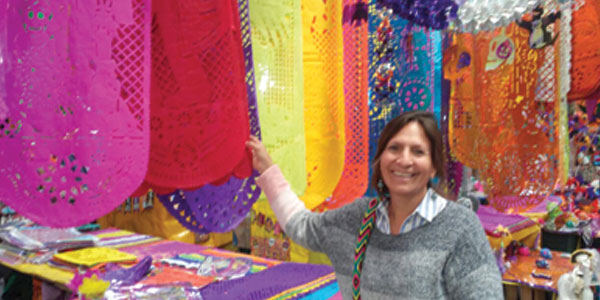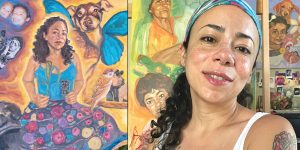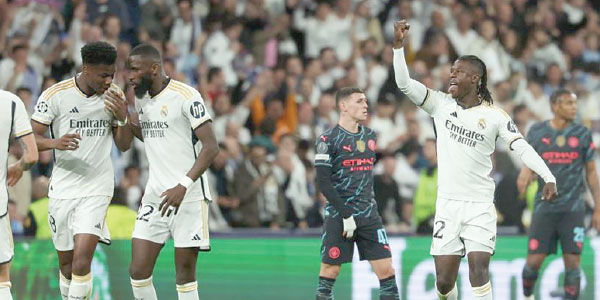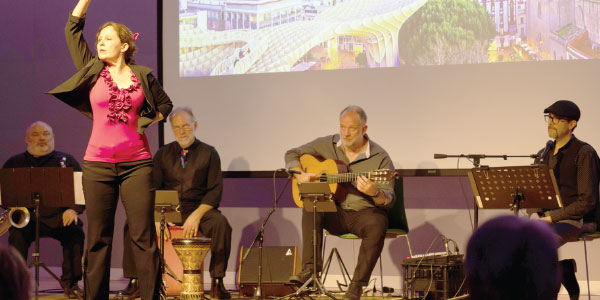
Dos Mundos supports the Dia de los Muertos (Day of the Dead in English) and Halloween celebrations in the Kansas City area. As a show of that support, the newspaper presents the following transcript of a recent interview with Mexican anthropologist Katina Vackimes, who shared her knowledge about both traditions:
Dos Mundos: Tell us what does it mean – the celebration of the Day of the Dead?
Katina Vackimes: It’s very different in every area, family or group. The true meaning behind (it), … (is) that it is supposed to be a way to honor a close relative that (has) passed away … no more than a year (ago). So you are offering their favorite stuff as a way to remember and honor them. The original belief states that the soul of the person that passed away in the last year is coming back to say goodbye. The relatives offer their favorite stuff and finally let them go to rest in peace.
DM: What are the principal elements of the Day of the Dead traditions?
KV: (Those are) … also different in every region. But it’s very important to put the favorite things of the deceased person (on the altar). In addition, it’s essential to build a path with different elements that will help the souls to get to their altars. Some of the principal elements of the path and the altar include candles that illuminate the soul’s journey, incense that will purify the energies of the place and scare bad spirits, water to quench the thirst of the souls and that also reflects their purity.
DM: (What) … is the origin of the Day of the Dead?
KV: It’s kind of a mixing of traditions. In the pre-Hispanic era, they used to bury the deceased with some stuff like food, jewelry and a dog that would guide … (the) soul. In the Christian … (era), they stopped putting this stuff in the graves and started building altars with the same intention – helping the soul. The souls are supposed to come and use the food (and) water to help them on their journey. So the modern Day of the Dead celebrations are a mix between the pre-Hispanic and Christian traditions.
DM: What are the differences between the Day of the Dead and Halloween?
KV: Well, … (Halloween) comes from Anglo-Saxon traditions. In the beginning, … (a fall) festival used to divide the season of autumn from winter – the season of death. The reality is that the Latin Day of the Dead is a happy way to remember the beloved souls that (have) passed away. And Halloween has a lot of elements that don’t have any kind of relationship with the meaning of the souls, like witches … (and) pumpkins.
DM: Do you think that (the) Day of the Dead and Halloween are traditions that complement each other?
KV: I don’t really think they can complement each other. Because these are very different traditions. First, the idea from Halloween’s ghosts can’t compare to the deeper meaning of the (Day of the Dead) souls that are coming to visit. What I mean is that the image of the (Halloween) ghosts and the (Day of the Dead) souls have totally different connotations.
Vackimes comparte conocimientos sobre el Día de los Muertos y las tradiciones de Halloween
Dos Mundos apoya el día de los muertos y las celebraciones de Halloween en el área de Kan-sas City. Como muestra de ese apoyo, el periódico presenta la siguiente transcripción de una reciente entrevista con la antropóloga mexicana Katina Vackimes, quien compartió su conocimiento sobre ambas tradiciones:
Dos Mundos: Cuéntanos ¿qué significa: la celebración del Día de los Muertos?
Katina Vackimes: Es muy diferente en cada área, familia o grupo. El verdadero significado detrás de ello, es que es una manera de honrar a un pariente cercano que ha fallecido en el último año. Por lo que ofreces sus cosas favoritas como una manera de recordarlas y honrarlas. La creencia original afirma que el alma de la persona que falleció en el último año regresa para despedirse. Los familiares les ofrecen sus cosas favoritas y finalmente los dejan ir a descansar en paz.
DM: ¿Cuáles son los principales elementos de las tradiciones del Día de los Muertos?
KV: Esos también son diferentes en cada región. Pero es muy importante poner las cosas favoritas de la persona fallecida en el altar. Además, es esencial construir un camino con diferentes elementos que ayudarán a las almas a llegar a sus altares. Algunos de los elementos principales del camino y el altar incluyen velas que iluminan el viaje del alma, incienso que purificará las energías del lugar y atemorizará a los malos espíritus, agua para saciar la sed de las almas y que también refleja su pureza.
DM: ¿Cuál es el origen del Día de los Muertos?
KV: Es una especie de mezcla de tradiciones. En la época prehispánica, solían enterrar al difunto con algunas cosas como comida, joyas y un perro que guiaría su alma. En la era cristiana dejaron de poner esto en las tumbas y comenzaron a construir altares con la misma intención: ayudar al alma. Se supone que las almas vienen y usan la comida y el agua para ayudarlos en su viaje. Entonces, las celebraciones modernas del día de los Muertos son una mezcla entre las tradiciones prehispánicas y cristianas.
DM: ¿Cuáles son las diferencias entre el Día de los Muertos y Halloween?
KV: Bueno, Halloween proviene de las tradiciones anglosajonas. Al principio, el inicio del festival solía dividir la temporada de otoño de invierno – la temporada de la muerte. La realidad es que el día de los muertos latino es una manera feliz de recordar a las almas queridas que han fallecido. Y Halloween tiene muchos elementos que no tienen ningún tipo de relación con el significado de las almas, como las brujas y las calabazas.
DM: ¿Crees que el día de muertos y Halloween son tradiciones que se complementan entre sí?
KV: Realmente no creo que se puedan complementar el uno al otro, porque estas son tradiciones muy diferentes. Primero, la idea de los fantasmas de Halloween no se puede comparar con el significado más profundo de las almas (del día de los muertos) que vienen de visita. Lo que quiero decir es que la imagen de los fantasmas (de Halloween) y las almas (del día de los muertos) tienen connotaciones totalmente diferentes.









